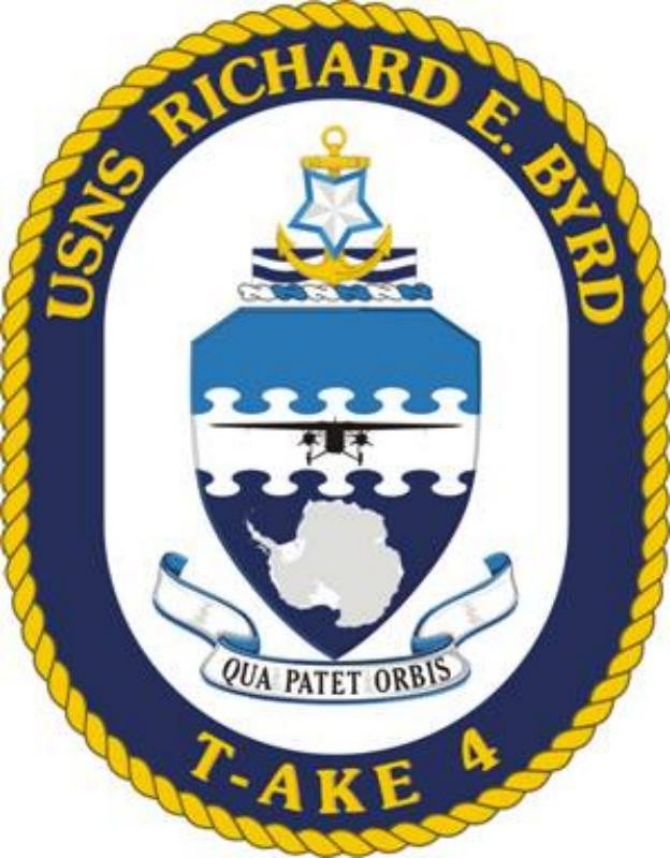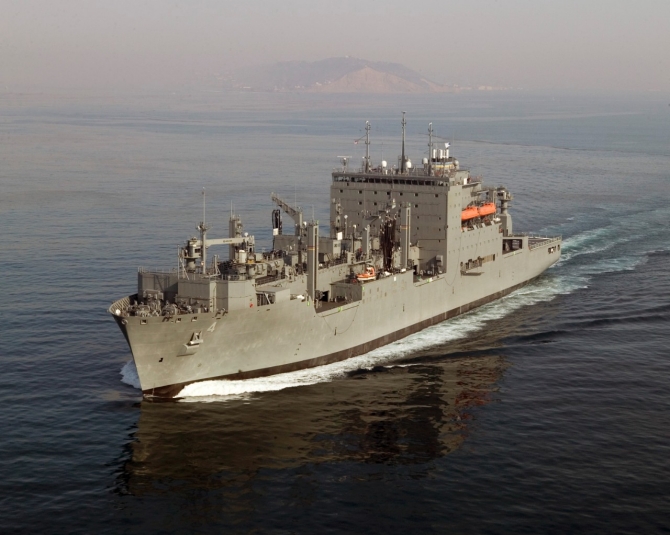Richard E. Byrd II (T-AKE-4)
2007-
Richard Evelyn Byrd (25 October 1888-11 March 1957).
The second ship to be named in honor of the courageous explorer. The first was guided missile destroyer Richard E. Byrd (DDG-23), that served from 1964-1992.
II
(T-AKE-4: displacement 42,528; length 689; beam 106'; draft 30'; speed 20 knots; complement 197; armament up to 6 .50 caliber or 7.62 millimeter machine guns, aircraft 2 Sikorsky MH-60S Knighthawks or 2 Eurocopter (Aérospatiale) AS332 Super Pumas; class Lewis and Clark)
The second Richard E. Byrd (T-AKE-4) was laid down on 17 July 2006 at San Diego, Calif., by General Dynamics National Steel and Shipbuilding Co.; launched on 15 May 2007; sponsored by Mrs. Bolling B. Clarke, the late admiral’s eldest daughter; and was placed in service with the Military Sealift Command (MSC) on 14 November 2007.

Shield
Dark blue and gold are the colors traditionally associated with the Navy. Rear Adm. Byrd’s area of exploration, illustrated by the following images: the lighter blue denotes the geographic position of the North Pole, in the middle of the Arctic Ocean; while the dark blue with the stylized landmass alludes to Antarctica located over the South Pole. The nebuly, the heraldic symbol for the sky, indicates Byrd’s career as an aviator. The silhouette of the Fokker Trimotor Josephine Ford and Ford Trimotor Floyd Bennett symbolizes the type of plane that the intrepid explorer flew over both regions, becoming the first person to fly over the South Pole and to attempt to fly to the North Pole. His accomplishments, further conveyed in the ship’s motto Qua Patet Orbis, highlights his exploration of both poles or “as far as the world extends”.
Crest
The billet and the wavys suggest Richard E. Byrd’s transport and delivery capabilities. The anchor symbolizes her strength at sea and steadfastness. The inverted star commemorates the ship’s namesake and his award of the Medal of Honor for his journey to the North Pole.

Richard E. Byrd reached the Seventh Fleet and began her forward deployed service with Logistics Group Western Pacific, also known as Task Force 73, on 24 July 2008. She subsequently relieved MSC-manned combat store ship Niagara Falls (AFS-3).
The Navy announced that about 50 sailors on board amphibious transport dock Dubuque (LPD-8) reported flu-like symptoms, and the Centers for Disease Control and Prevention (CDC) confirmed at least one of the cases as the Influenza A virus subtype H1N1, on 5 May 2009. The disease struck during the worldwide swine flu outbreak and as a result, the Navy cancelled the ship’s June 2009 deployment to Oceania in support of the Pacific Partnership 09 program, humanitarian civic assistance missions. Richard E. Byrd therefore sailed to fulfill the Navy’s commitment to the program. Commander Amphibious Squadron 2 broke his flag in the ship, and additional staff members, and government and civilian humanitarian aid workers embarked, raising the total number of people on board to nearly 300. Richard E. Byrd visited American Samoa, Tonga, New Caledonia, and Kiribati (Tarawa).
A magnitude 9.0 (Mw) undersea megathrust earthquake occurred off the Tōhoku region of Honshū, Japan, at 1446 on 11 March 2011. The earthquake triggered tsunami waves that reached more than 100 feet in height at places, and caused nearly 25,000 casualties, including more than 15,000 killed. The United States initiated Operation Tomodachi (from the Japanese Tomodachi Sakusen: Operation Friend[s]) to provide humanitarian relief to the victims. A total of 24,000 U.S. servicemembers, 189 aircraft, and 24 ships served in Tomodachi (12 March–4 May 2011).
Richard E. Byrd lay moored at Singapore when the disaster struck. She made for Japanese waters and reached the area off Sendai on 30 March. Her embarked Pumas delivered a variety of supplies to guided missile destroyer Preble (DDG-88) and dock landing ships Harpers Ferry (LSD-49) and Tortuga (LSD-46). A Puma carried a pallet from Richard E. Byrd to Tortuga, while the dock landing ship sailed just 300 yards off the auxiliary dry cargo ship’s port side, during one such evolution on 31 March. Thick fog blanketed both ships and compelled the helicopter to return to Richard E. Byrd. “At one point,” Richard E. Byrd’s Chief Mate Fred Cullen recalled, “we lost sight of Tortuga completely.” The Puma completed supplying Tortuga when the fog lifted. Richard E. Byrd carried out 16 underway replenishment evolutions, delivering 210,000 gallons (800 m³) of fuel to ships during Tomodachi.
Detailed history under construction.
Mark L. Evans
28 May 2014


